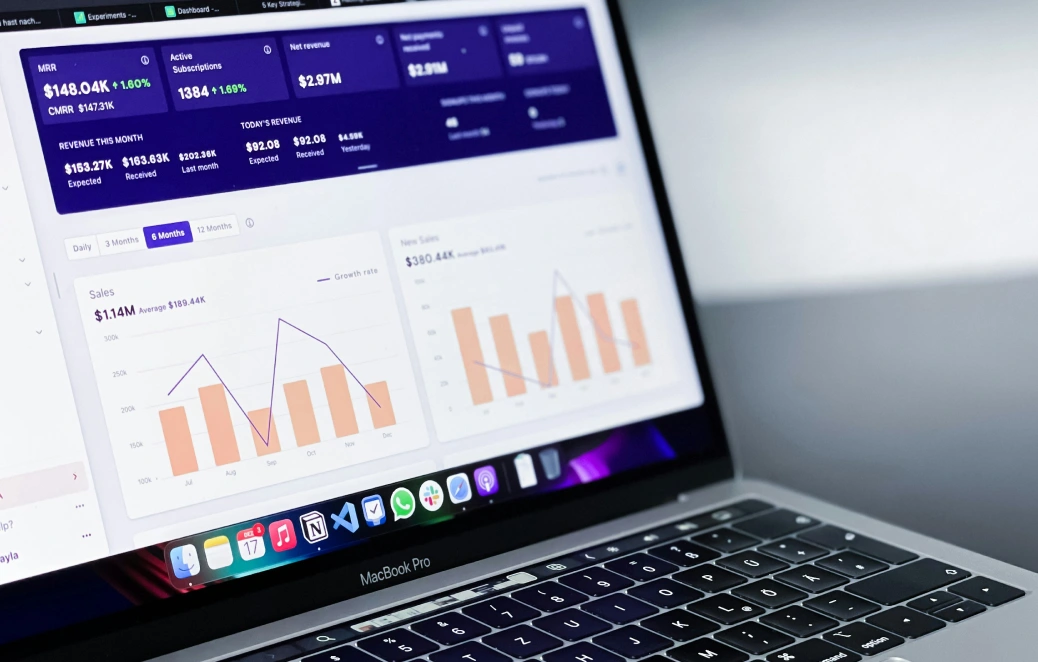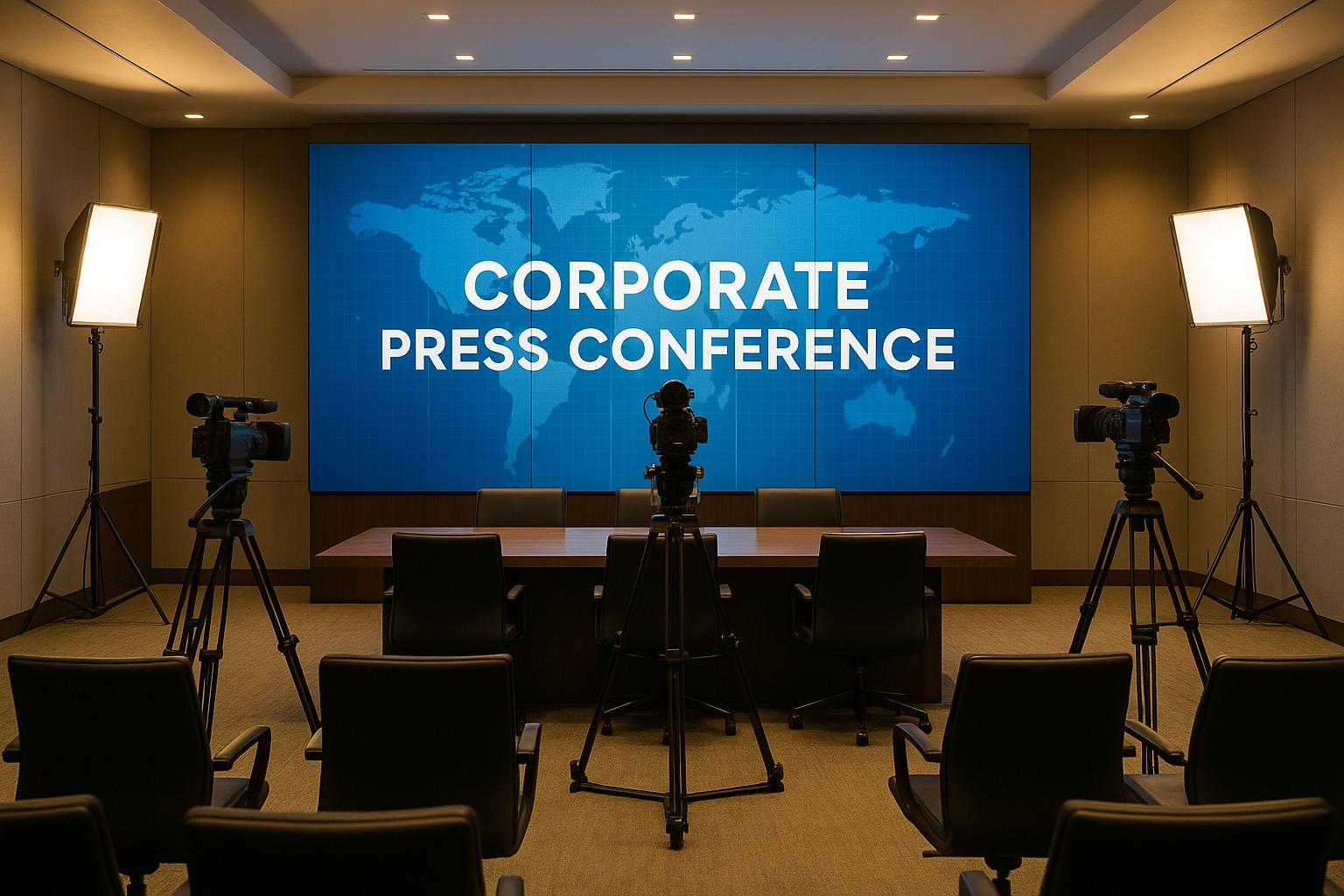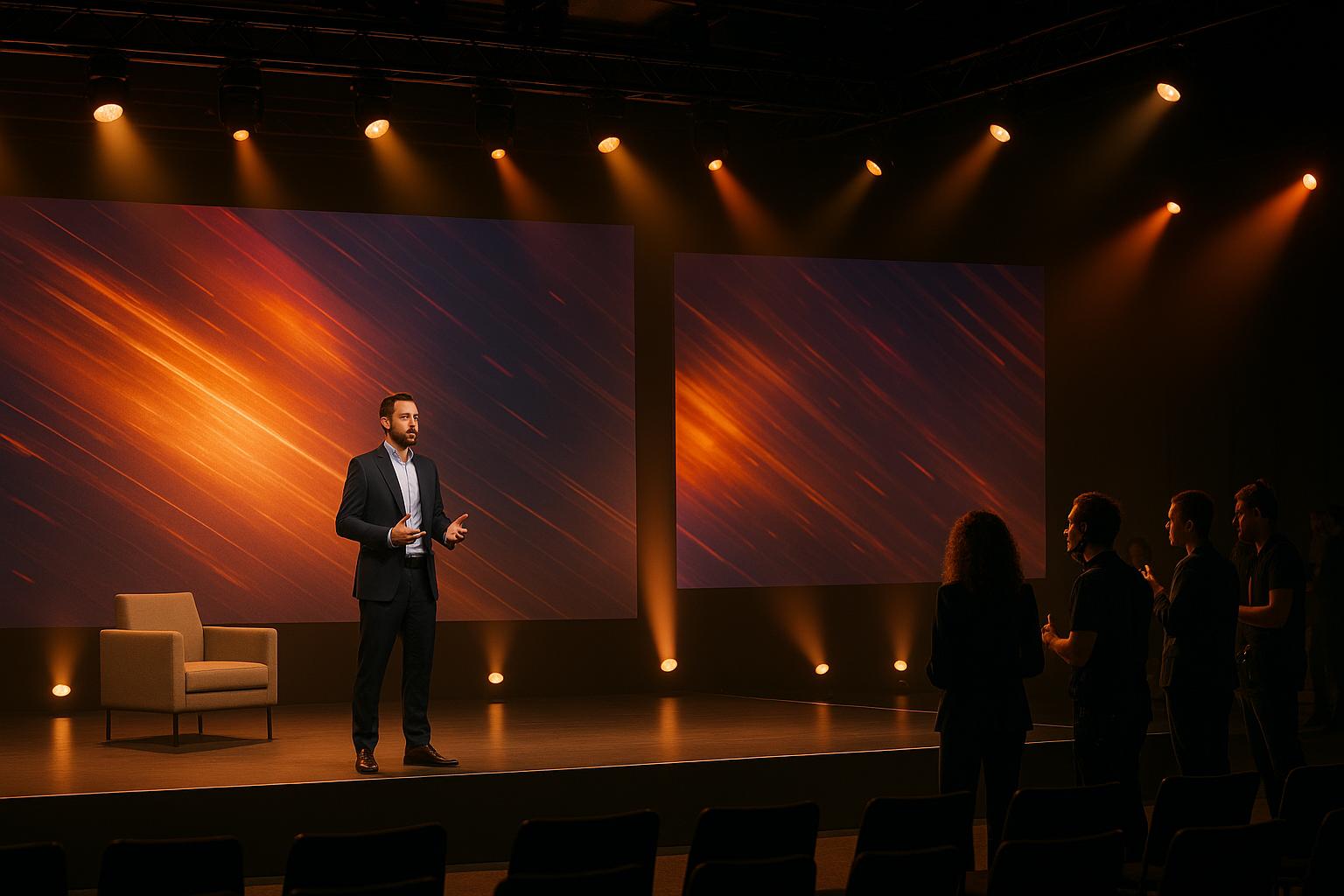How Production Companies Manage Global Board Meetings

Chief Executive Officer

Global board meetings are high-stakes events where decisions shape businesses, impact employees, and influence revenue. Managing these meetings requires detailed planning, advanced technology, and precise execution to ensure seamless collaboration across time zones and locations. Here's how production companies handle them effectively:
- Planning Ahead: Early preparation includes creating timelines, coordinating schedules, and setting clear objectives. Risk management plans and backup systems are essential to avoid disruptions.
- Technology Setup: Reliable internet (minimum 25 Mbps upload, 50 Mbps download), 4K cameras, advanced microphones, and backup systems ensure smooth communication. Hybrid setups bridge in-person and virtual participants.
- Time Zone Management: Scheduling tools like World Clock Pro help balance global time zones. Rotating meeting times quarterly ensures fairness across regions.
- Cultural Considerations: Providing pre-meeting materials in advance, using clear formats (e.g., 24-hour time, ISO dates), and respecting regional holidays improve participation and understanding.
- Security: Encryption, access controls, and NDAs protect sensitive discussions. Physical and digital safeguards ensure confidentiality.
- Post-Event Follow-Up: Quick sharing of recordings, action item tracking, and performance analysis turn discussions into actionable outcomes.
Production companies excel by combining technical expertise with logistical precision, ensuring global board meetings run smoothly and deliver results.
Planning and Logistics Setup
The success of any global board meeting hinges on meticulous planning that starts well in advance. Every detail is carefully mapped out to avoid costly mistakes and ensure everything runs seamlessly.
Creating a Detailed Timeline
Planning typically kicks off weeks or even months ahead of the event. Early on, key stakeholders are consulted, participant schedules are checked, and potential venues are explored. This phase focuses on defining the meeting's core objectives and setting the stage for success. As the event date approaches, production teams conduct technical rehearsals to fine-tune audiovisual setups, test network capabilities, choose hybrid meeting platforms, and finalize security protocols. Contingency plans are also put in place. To keep everything on track, milestone checkpoints are established, with clear responsibilities and deadlines assigned to ensure smooth coordination across time zones and organizational layers.
Identifying Key People and Setting Up Communication
The planning process involves a variety of stakeholders, including board members, executives, legal advisors, corporate secretaries, IT teams, security personnel, venue coordinators, and translation services. To keep everyone aligned, production teams set up tailored communication channels for each group. For example, executives might receive updates through secure emails or briefings, while technical teams rely on project management tools for real-time collaboration. Escalation protocols and designated points of contact are also established to streamline decision-making and address any issues quickly.
Budget Planning for High-Level Events
Budgeting for a global board meeting includes allocating funds for backup systems, venue costs, technology needs, security measures, and travel arrangements. By conducting a cost-benefit analysis of different formats - such as fully in-person versus hybrid - organizations can make informed decisions that align with their goals and risk tolerance.
Choosing Venues and Meeting Legal Requirements
Selecting the right venue for a global board meeting goes beyond the usual considerations for event spaces. Venues must offer high-speed internet, reliable electrical capacity, secure areas for private discussions, and compliance with legal requirements such as privacy laws, data residency rules, and ADA accessibility standards. Controlled access points are also essential to manage different groups of participants securely.
Risk Planning and Backup Strategies
Given the complexities of global board meetings, robust risk planning is essential. Production teams create detailed risk matrices to anticipate challenges like technical glitches, communication failures, security breaches, or even natural disasters. Backup plans might include redundant internet connections, backup power systems, and duplicate audiovisual setups. Communication contingencies are developed for scenarios where key participants face travel delays or emergencies. Security measures - such as access controls, monitoring protocols, and incident response plans - are also put in place to handle potential threats. Regular tests and rehearsals ensure these strategies are ready to tackle unexpected situations.
Once the logistics are locked in, the focus shifts to the technology setup needed to deliver a flawless meeting experience.
Technology Setup and Audiovisual Equipment
Hosting global board meetings demands a robust technical setup to ensure seamless communication and collaboration. High-quality infrastructure is essential to keep everything running smoothly, especially when stakes are high.
Network and Internet Connection Needs
To maintain smooth video, clear audio, and real-time document sharing, each location should have a minimum of 25 Mbps upload and 50 Mbps download speeds. For venues hosting multiple participants, these requirements need to scale accordingly.
For added reliability, dedicated internet circuits with bonded connections combine multiple lines to create redundancy and boost capacity. This approach minimizes the risk of interruptions during key moments.
IT teams should configure Quality of Service (QoS) protocols to prioritize meeting traffic. Separating meeting traffic onto dedicated VLANs ensures routine office internet usage doesn’t interfere with the session. Additionally, latency testing should be performed between all global locations at least a week before the meeting, keeping delays under 150 milliseconds to maintain natural conversation flow.
Firewall and security configurations are also crucial. Many organizations set up temporary DMZ networks specifically for board meetings, allowing secure access to meeting platforms without compromising the main corporate network.
AV Equipment and Hybrid Meeting Setup
A professional audiovisual setup is key for both in-person and remote participants. For video, 4K PTZ cameras (pan-tilt-zoom) are often used, with at least three cameras per room to capture wide angles, speaker close-ups, and presentation materials. Some setups now include AI-powered auto-tracking cameras, which follow speakers automatically. For audio, ceiling-mounted microphone arrays or lapel mics paired with digital signal processors (DSPs) ensure clear sound by adjusting volume levels and eliminating echo.
On the visual side, multiple screens serve different roles. Confidence monitors show participants what remote attendees see, while presentation displays handle shared documents and slides. Additional participant view screens display remote attendees, helping bridge the gap between in-person and virtual participants.
Lighting is another important factor. LED panel systems with adjustable color temperatures (3200K to 5600K) ensure everyone looks professional on camera. Proper key and fill lighting eliminates harsh shadows, helping participants appear polished and engaged.
For hybrid meetings, integration platforms ensure a seamless connection between in-person and remote attendees. These systems synchronize room cameras with individual webcams, balance room audio with computer speakers, and manage screen-sharing capabilities across physical and virtual environments. The goal is to make remote attendees feel as though they’re right there at the table.
Control systems simplify operations by allowing technical operators to manage everything - camera angles, microphone levels, lighting, and displays - from a single interface. Many setups include preset configurations tailored for different meeting phases, such as presentations, discussions, or voting.
Backup Systems and Technical Practice Runs
Backup systems are essential to avoid disruptions. Deploy primary fiber, secondary cable, and cellular backups with 5G capabilities. Automatic failover systems ensure a seamless switch between connections if the primary line fails. Redundancy should extend to all critical components, with backup cameras, spare microphones, and additional displays ready for immediate use.
Power outages can’t be overlooked. Battery backup systems should provide at least two hours of runtime for critical equipment, while generator backups support longer sessions or multi-day meetings. Power conditioning equipment protects sensitive AV gear from voltage fluctuations that could lead to failures.
Practice makes perfect, and technical rehearsals are a must. These should occur 48 to 72 hours before the meeting to test connections, verify audio quality, and confirm screen-sharing functionality. Full dress rehearsals with stand-in participants can help fine-tune details like camera angles, lighting, and audio pickup.
To prepare for unexpected issues, stress testing simulates worst-case scenarios such as bandwidth limitations, equipment failures, and participant connection problems. Load tests ensure the system can handle maximum participants and peak data usage, while recovery time tests measure how quickly backups can take over in case of failure.
Finally, documentation and runbooks provide clear steps for troubleshooting common issues and handling emergencies. Technical support teams are briefed on escalation procedures to resolve problems quickly without disrupting the meeting. Communication protocols ensure that any issues are discreetly reported to organizers, keeping the meeting flow intact.
With this robust setup, organizations can ensure their board meetings run smoothly, even across multiple time zones and locations.
Managing Multiple Time Zones and Communication
Organizing global board meetings across various time zones takes thoughtful planning and clear communication to ensure everyone feels included and can participate effectively. This process naturally ties into selecting the right tools and strategies for scheduling.
Time Zone Planning and Scheduling Tools
When arranging meetings for participants spanning the globe, it’s almost inevitable that someone will have to join outside their typical work hours. To make this fair, rotate meeting times quarterly so that the inconvenience is shared among regions like Asia-Pacific, Europe/Africa, and the Americas.
Tools such as World Clock Pro and TimeZone iOS are incredibly helpful for visualizing overlapping business hours and identifying the best time slots. For more intricate scheduling, Calendly’s team scheduling feature allows members to input their availability, automatically suggesting the most suitable meeting times.
It’s crucial to confirm the local time and date with every participant to avoid confusion or last-minute issues. To ensure a smoother experience, consider adding a 15–30-minute buffer before and after the meeting for connection troubleshooting and casual networking. Many organizations also use a "soft start" approach, dedicating the first 10 minutes to technical checks and informal conversation before diving into the agenda.
Pre-Meeting Materials and Cultural Sensitivities
For global audiences, distribute meeting materials at least 72 hours in advance. This allows time for translation, if necessary, and gives participants ample opportunity to prepare questions or comments.
When preparing documents, stick to international standards to avoid misunderstandings. Use the 24-hour time format (e.g., 14:00 instead of 2:00 PM) and the ISO date format (e.g., 2025-10-15). Be specific with financial figures by clearly stating the currency, and include both metric and imperial units for measurements when applicable.
Cultural differences can also shape meeting dynamics. For instance, German and Swiss participants often appreciate detailed agendas with precise time allocations, while Japanese board members may expect longer discussions to build consensus. American participants tend to prefer direct communication and quick decisions, whereas British colleagues might rely on more diplomatic phrasing that requires careful interpretation.
Even when English is the shared language, adjust your speaking pace and simplify sentence structures for non-native speakers. Avoid idioms or cultural references that might confuse participants. Providing written summaries of key decisions during the meeting can help ensure everyone is on the same page.
Also, take religious and cultural holidays into account when scheduling. For example, Ramadan impacts meeting times for Muslim participants, Chinese New Year affects availability in Asia, and many Europeans take extended vacations in August. Maintaining a global holiday calendar can help you plan around these observances.
Live Translation and Off-Time Communication
Once scheduling is in place, bridging language and timing gaps becomes the next priority. Professional interpretation services are invaluable when participants aren’t comfortable conducting business in English. Use simultaneous interpretation for formal presentations and structured discussions, while consecutive interpretation works better for smaller groups or Q&A sessions.
For real-time captions, tools like Zoom’s live transcription feature can be helpful, although human interpreters are typically more accurate for specialized business terms. Many companies hire interpreters skilled in corporate governance and confidentiality to ensure discussions remain precise and secure.
To address time zone gaps, asynchronous communication protocols are essential. Platforms like Slack or Microsoft Teams allow board members to ask questions, share updates, and continue discussions outside of formal meetings. Set clear response time expectations, such as 24–48 hours, to accommodate varying schedules.
For more nuanced communication, voice platforms like Voxer enable members to record detailed messages that preserve tone and context. These recordings can be reviewed at convenient times, making them ideal for tackling complex topics.
Collaborative tools like Google Workspace or Microsoft 365 allow real-time editing and commenting across time zones. Use version control to avoid conflicts when multiple people are working on the same document.
After meetings, structured follow-up is critical. Share recordings within 2 hours, along with time-stamped summaries that highlight key decisions and next steps. Regional coordinators can help relay updates and gather feedback from members who couldn’t attend due to time zone conflicts.
For urgent matters, establish emergency communication protocols. These should include clear escalation procedures, taking regional business hours into account, and identifying backup contacts in each time zone to ensure critical issues are addressed promptly.
These approaches strengthen the communication framework, ensuring global boards operate efficiently no matter the location or language.
sbb-itb-ae35a94
Live Event Production and Management
Once the planning and technical groundwork are in place, the focus shifts to executing the live event. A smooth execution hinges on a well-prepared team and clear protocols to address any unexpected challenges.
On-Site Staff and Job Assignments
Pulling off a successful global board meeting requires a team with clearly defined roles. At the helm is the technical director, who oversees all technical operations and makes real-time decisions about audio, video, and streaming quality. The audio engineer is responsible for sound, ensuring crystal-clear audio for both in-person and virtual attendees, managing microphones, and eliminating feedback. Meanwhile, the event producer handles the flow of the meeting, from introductions to break schedules, and coordinates with catering or security teams.
Regional coordinators in each time zone play a crucial role in offering localized support. They address issues like internet disruptions or power outages, ensuring continuity. The streaming technician monitors the broadcast for remote participants, ensuring high-quality streaming, managing bandwidth, and overseeing recording functions.
To keep everything running smoothly, team members must rely on redundant communication channels that allow them to coordinate without disrupting the meeting.
Show Flow Documents and Problem Solving
A well-crafted show flow document is the backbone of the event, detailing every step of the meeting. It includes everything from pre-event tech checks to post-meeting wrap-ups. This document outlines exact timings for agenda items, technical cues for transitions, and scheduled breaks that accommodate global time zones.
The show flow also provides handoff procedures between speakers and includes detailed contingency plans for common technical hiccups. For instance, if a remote attendee loses their connection, the document specifies whether to pause the meeting, switch to a phone connection, or adjust the agenda. These pre-planned protocols ensure that small issues are resolved quietly, while major disruptions trigger backup plans tailored to the situation.
It’s essential to keep the show flow document updated and rehearse contingency plans. Any updates should be shared with the team no later than 24 hours before the meeting begins. Alongside operational efficiency, robust security measures are non-negotiable to protect the integrity of the event.
Security and Privacy Protection
Security is a top priority during live events, especially those involving sensitive discussions. Access control starts with invitation-only meeting links that expire immediately after the session concludes. Waiting room features add an extra layer of verification, ensuring only authorized participants join.
All production staff, including temporary contractors and regional coordinators, must sign non-disclosure agreements (NDAs). These agreements cover restrictions on recording and handling sensitive information, extending well beyond the event itself.
For streaming security, encrypted platforms with enterprise-level protection are a must. Features like blocking unauthorized recordings or screen captures are critical. Some organizations even use watermarked screens to trace any unauthorized activity back to the individual responsible.
Physical security at the venue is equally important. Access to control rooms should be restricted, and catering or cleaning staff should not enter during confidential discussions. Data protection for recordings and transcripts is vital; they should be stored on secure servers with limited access and automatic deletion schedules.
Network security is another critical layer. Dedicated internet connections are preferred over shared venue WiFi to minimize risks. Emergency protocols should be in place to handle situations like unauthorized attendees, technical breaches, or external disruptions. These protocols might include immediately ending the meeting or securing any recorded content to prevent further issues.
After-Event Tasks and Data Analysis
What happens after an event often determines its long-term impact. Just like pre-event planning and live production, what you do after the meeting plays a crucial role in its overall success. Production teams need a well-thought-out approach to turn raw meeting content into actionable outcomes while gathering insights to improve future events.
Meeting Notes and Recording Sharing
Getting meeting materials to the right people quickly and securely is a top priority. Within half an hour of the event's conclusion, teams start processing recordings and compiling notes.
Recordings are segmented by agenda items, and audio quality is improved by removing background noise and balancing volume differences between speakers. Automated transcription tools provide a starting point, but human reviewers step in to fix errors, especially with technical terms or proper names that AI might misinterpret.
These recordings are then uploaded to secure portals with restricted access. For board members in different regions, customized packages are created, including time-stamped summaries that highlight decisions relevant to their specific responsibilities.
Hybrid meetings present unique challenges, particularly with audio quality. Production teams address this by creating enhanced versions of recordings for remote participants, which might include boosting quiet speakers' audio or reducing echo from conference room microphones.
For international compliance, recordings may need to be stored in specific regions to meet data sovereignty regulations. Some companies solve this by maintaining servers in multiple countries, automatically routing files based on participant citizenship or corporate registration requirements.
Action Item Tracking and Follow-Up
Once documentation is complete, the focus shifts to ensuring meeting outcomes are carried out effectively. Real-time tools flag decisions and assignments during the event, keeping everything organized.
Action items are tracked using digital dashboards that send automated reminders to responsible parties as deadlines approach. These dashboards are accessible from any device, making it easy for board members to stay on top of commitments, even across time zones.
When action items involve multiple countries or business units, regional liaisons step in to bridge gaps. These liaisons don’t just translate language - they also navigate local business practices and communication styles, ensuring smoother collaboration between global headquarters and regional teams.
To streamline operations, action items integrate directly into existing project management tools like Microsoft Project or Asana. This eliminates the need for manual data entry and reduces the risk of tasks being overlooked. If deadlines are missed, built-in escalation protocols notify key individuals - whether it’s an executive assistant, regional manager, or board chair - based on the priority and potential impact of the item.
Performance Measurement and Future Improvements
Beyond follow-ups, evaluating performance is essential for uncovering areas that need improvement. Data is collected during the event and for up to 30 days afterward.
Technical performance metrics form the foundation for operational tweaks. These include connection stability percentages by region, participant-rated audio quality scores, and platform uptime statistics. By analyzing data from different internet providers and devices, companies can pinpoint patterns that might affect future events.
Engagement analytics help gauge how well the meeting served its purpose. Metrics like active participation rates, question submissions during Q&A sessions, and attention metrics (showing when participants were engaged versus multitasking) provide valuable insights. These findings help refine meeting formats and scheduling.
Cost analysis breaks down expenses by category and region, highlighting areas for efficiency gains. This includes evaluating vendor performance, assessing technology ROI, and analyzing staff utilization rates. Often, investing in better technology upfront can save money in the long run by reducing the need for extensive technical support during live events.
Feedback collection goes beyond basic surveys. Structured interviews with key participants from different regions provide deeper insights into preferences and communication styles. For instance, some regions may favor structured discussions, while others prefer open dialogue. These insights help tailor future meetings to better suit participants.
To ensure these lessons lead to meaningful changes, production teams maintain event evolution documents that track improvements in meeting formats, technology choices, and logistics. These documents serve as valuable resources for planning similar events in the future or onboarding new clients with comparable needs.
The best production companies treat each global board meeting as both a one-time event and a learning experience. This approach helps them refine their expertise in managing complex, multi-regional communications, ensuring they continue to improve with every event.
Conclusion: Main Points for Managing Global Board Meetings
Global board meetings require a precise and well-rounded approach to ensure success. It all starts with thorough planning and clear protocols to tackle potential challenges before they arise. Budget planning, in particular, plays a key role when working across multiple countries, as expenses can quickly spiral without proper oversight and careful vendor management.
Reliable technology is the backbone of smooth collaboration in real-time. High-quality audiovisual tools and hybrid meeting setups are essential for board members spread across continents to communicate effectively and stay engaged.
Attention to cultural differences and smart time zone management can significantly enhance the quality of these meetings. Acknowledging regional business norms, providing materials in suitable formats, and scheduling meetings that align with participants' local contexts show professionalism and respect. This blend of meticulous planning, advanced technology, and cultural understanding ensures that every aspect of the event runs smoothly.
The process doesn’t end with the meeting itself. Live event coordination and post-event follow-up are just as important. Assigning clear roles to a dedicated team, maintaining detailed schedules, and implementing robust security measures help handle unexpected challenges. After the meeting, quick documentation, organized tracking of action items, and a thorough review of outcomes transform discussions into actionable strategies.
Production companies that excel in these areas become more than just service providers - they become strategic partners. They understand the high stakes of global board meetings, where decisions can impact thousands of employees and millions in revenue. By blending technical know-how with cultural sensitivity and operational precision, these companies ensure that distance and geography never stand in the way of effective leadership and decision-making.
FAQs
What technology is essential for running effective global board meetings?
To host successful global board meetings, a dependable video conferencing platform is a must. Look for one that offers high-definition video, crisp audio, and useful features like breakout rooms for more focused discussions. Equally important are secure collaboration tools to handle document sharing, voting, and real-time communication seamlessly. Testing all technology ahead of time and establishing clear participation guidelines can go a long way in ensuring smooth operations, even across different time zones and locations.
How do production companies address cultural differences during global board meetings?
Production companies place a strong emphasis on creating an environment where respect and understanding of different backgrounds thrive. They actively encourage board members to learn about each other's customs and traditions, which not only strengthens relationships but also helps prevent potential missteps or misunderstandings.
To make sure everyone feels included, these companies take practical steps to address key cultural needs. This might involve accommodating religious observances, honoring dietary preferences, or scheduling meetings at times that suit various time zones and traditions. By fostering open communication and staying mindful of diverse viewpoints, they cultivate a space where collaboration and mutual respect can flourish.
How do production companies ensure security and confidentiality during global board meetings?
To maintain security and confidentiality during global board meetings, production companies rely on a mix of cutting-edge technology and strict procedures. Access to meeting areas is tightly controlled through keycard systems or biometric authentication, ensuring only approved individuals can enter. On top of that, secure communication platforms with end-to-end encryption are used to keep sensitive conversations protected.
To further safeguard proprietary information, participants are required to adhere to comprehensive confidentiality agreements and follow well-defined policies. They also receive training on how to prevent unauthorized disclosures and handle cybersecurity threats effectively. These steps are critical for protecting high-level discussions while enabling smooth collaboration across different locations and time zones.
Related Blog Posts









